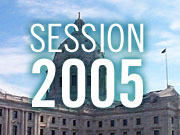February 28, 2005
 |
| State economist Tom Stinson says the state's economy appears to be strong, except in the area of job creation. (MPR Photo/Tom Scheck) |
St. Paul, Minn. — Minnesota's fiscal picture has improved since the last revenue forecast showed a projected $700 million deficit for the next biennium. Finance officials say tax collections are coming in higher than anticipated, and they now expect the deficit to be $466 million.
Finance Commissioner Peggy Ingison says the change is minimal in a $30 billion state budget.
"This certainly is good news, things are moving in the right direction, but I wouldn't suggest that this is a change that's particularly dramatic at all," she said.
State economist Tom Stinson says Minnesota's employment growth lagged behind the U.S. average last year, but the forecast projects strong employment growth in the future.
"We expect 44,000 more jobs to be added in Minnesota's economy this year -- 103,000 by the end of 2007. But for those of us who get paid to worry about the economy, the employment growth in Minnesota is a concern because we know, just because we forecast something is going to happen doesn't mean it's going to happen," Stinson said.
The forecast also doesn't include an inflationary increase, which some lawmakers say is a more realistic way to look at the budget. That would bring the projected deficit to about $1.1 billion.
Gov. Pawlenty says the new forecast shows that Minnesota's financial situation is much better than when he took office, when the state faced a $4.5 billion deficit.
"We've almost climbed out of the hole," Pawlenty said. "And that's a major, major piece of progress in less than a two-year period, and we're proud of it, and we also want to roll up our sleeves and make sure we finish the job."
Pawlenty will use the new forecast to revise his budget in the next few days. He had proposed using a combination of spending cuts, gambling money and other revenues to erase the deficit. He says the forecast will not affect his push for a new casino to be run jointly by the state and interested Indian tribes. He included $200 million from a casino licensing fee in his budget.
DFL leaders say Pawlenty should rethink his position on a new casino. And they say the state's finances aren't as rosy as the picture painted by Republicans. House Minority Leader Matt Entenza of St. Paul says Minnesota continues to be in deficit mode because of Republican budget policies.
"The governor and Republican leaders are in denial when they don't recognize that the billion-dollar deficit that grows into the future is being caused directly by the lack of investment in Governor Pawlenty's budget," he said.
Entenza stopped short of calling for a tax increase, but says DFLers are holding hearings around the state and will release their own budget proposal in mid-March.
Republican leaders say the forecast shows good fiscal management by Pawlenty. House Speaker Steve Sviggum says since the projected deficit is smaller, there may be money to alleviate some spending pressures in areas such as education and long-term care.
"We still have significant needs that are out there. We're not out of the woods yet, but that light gets a little brighter all the time," according to Sviggum.
Sviggum also acknowledged that the size of the bonding bill may grow because of the new numbers. Last week, the House passed a capital investment package totaling $816 million, while the Senate version was about $200 million more. House and Senate negotiators could soon begin meeting to work out differences.
There's another bright spot in the forecast. Finance officials predict that the state will end the current fiscal year in June in the black, with a $175 million balance; $25 million will be used to replenish the state's budget reserves, while the remaining $150 million will go toward paying back a payment shift for Minnesota schools.







